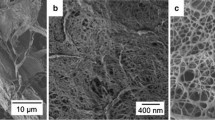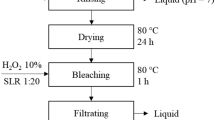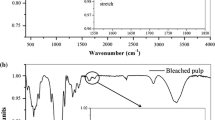Abstract
This paper reports the possibility of producing cellulose nanofiber from softwood pulp using a simple ball milling technique under ambient pressure and at room temperature. The effects of milling conditions including the ball-to-cellulose mass ratio, milling time, ball size and alkaline pretreatment were investigated. It was found that milling-ball size should be carefully selected for producing fibrous morphologies instead of particulates. Milling time and ball-to-cellulose mass ratio were also found important to control the fiber morphology. Alkali pre-treatment helped in weakening hydrogen bonds between cellulose fibrils and removing small particles, but with the risks of damaging the fibrous morphology. In a typical run, cellulose nanofiber with an average diameter of 100 nm was obtained using soft mechanical milling conditions using cerium-doped zirconia balls of 0.4–0.6 mm in diameter within 1.5 h without alkaline pretreatment.












Similar content being viewed by others
References
Abdul Khalil HPS, Bhat AH, Ireana Yusra AF (2012) Green composites from sustainable cellulose nanofibrils: a review. Carbohydr Polym 87(2):963–979
Abdul Khalil HPS, Davoudpour Y, Islam MN, Mustapha A, Sudesh K, Dungani R, Jawaid M (2014) Production and modification of nanofibrillated cellulose using various mechanical processes: a review. Carbohydr Polym 99:649–665
Abe K, Iwamoto S, Yano H (2007) Obtaining cellulose nanofibers with a uniform width of 15 nm from wood. Biomacromolecules 8(10):3276–3278
Abe K, Nakatsubo F, Yano H (2009) High-strength nanocomposite based on fibrillated chemi-thermomechanical pulp. Compos Sci Technol 69(14):2434–2437
Arbatan TL, Zhang X, Fang Y, Shen W (2012) Cellulose nanofibers as binder for fabrication of superhydrophobic paper. Chem Eng J 210:74–79
Azizi Samir MAS, Alloin F, Dufresne A (2005) Review of recent research into cellulosic whiskers, their properties and their application in nanocomposite field. Biomacromolecules 6(2):612–626
Bhatnagar A, Sain M (2005) Processing of cellulose nanofiber-reinforced composites. J Reinf Plast Compos 24(12):1259–1268
Bodin A, Backdahl H, Risberg B, Gatenholm P (2007) Nano cellulose as a scaffold for tissue engineered blood vessels. Tissue Eng 13(4):885
Bondeson D, Mathew A, Oksman K (2006) Optimization of the isolation of nanocrystals from microcrystalline cellulose by acid hydrolysis. Cellulose 13(2):171–180
Brown AJ (1886) On an acetic ferment which forms cellulose. J Chem Soc Trans 49:432–439
Brown Jr MR, Czaja W, Jeschke M, Young DJ (2006) Multiribbon nanocellulose as a matrix for wound healing, US Patent App. 20,070/053,960
Corrêa A, de Morais Teixeira E, Pessan L, Mattoso L (2010) Cellulose nanofibers from curaua fibers. Cellulose 17(6):1183–1192
Czaja W, Krystynowicz A, Bielecki S, Brown JRM (2006) Microbial cellulose-the natural power to heal wounds. Biomaterials 27(2):145–151
Eichhorn SJ (2011) Cellulose nanowhiskers: promising materials for advanced applications. Soft Matter 7(2):303–315
French AD (2014) Idealized powder diffraction patterns for cellulose polymorphs. Cellulose 21:885–896
Frey MW (2008) Electrospinning cellulose and cellulose derivatives. Polym Rev 48(2):378–391
Fukuzumi H, Saito T, Iwata T, Kumamoto Y, Isogai A (2008) Transparent and high gas barrier films of cellulose nanofibers prepared by tempo-mediated oxidation. Biomacromolecules 10(1):162–165
Henriksson M, Henriksson G, Berglund LA, Lindström T (2007) An environmentally friendly method for enzyme-assisted preparation of microfibrillated cellulose (MFC) nanofibers. Eur Polymer J 43(8):3434–3441
Henriksson M, Berglund LA, Isaksson P, Lindström T, Nishino T (2008) Cellulose nanopaper structures of high toughness. Biomacromolecules 9(6):1579–1585
Hubbe MA, Rojas OJ, Lucia LA, Sain M (2008) Cellulosic nanocomposites: a review. BioResources 3(3):929–980
Iwamoto S, Nakagaito A, Yano H (2007) Nano-fibrillation of pulp fibers for the processing of transparent nanocomposites. Applied Physics a-Materials Science & Processing 89(2):461–466
Jazaeri E, Zhang L, Wang X, Tsuzuki T (2011) Fabrication of carbon nanofiber by pyrolysis of freeze-dried cellulose nanofiber. Cellulose 18(6):1481–1485
Kim CW, Kim DS, Kang SY, Marquez M, Joo YL (2006) Structural studies of electrospun cellulose nanofibers. Polymer 47(14):5097–5107
Koch CC (1997) Synthesis of nanostructured materials by mechanical milling: problems and opportunities. Nanostruct Mater 9(1–8):13–22
Lavoine N, Desloges I, Dufresne A, Bras J (2012) Microfibrillated cellulose—its barrier properties and applications in cellulosic materials: a review. Carbohydr Polym 90(2):735–764
Moran JI, Alvarez VA, Cyras VP, Vazquez A (2008) Extraction of cellulose and preparation of nanocellulose from sisal fibers. Cellulose 15:149–159
Nakagaito A, Yano H (2004) The effect of morphological changes from pulp fiber towards nano-scale fibrillated cellulose on the mechanical properties of high-strength plant fiber based composites. Appl Phys A Mater Sci Process 78(4):547–552
Nishiyama Y, Langan P, Chanzy H (2002) Crystal structure and hydrogen-bonding system in cellulose IÎ2 from synchrotron X-ray and neutron fiber diffraction. J Am Chem Soc 124(31):9074–9082
Nogi M, Yano H (2008) Transparent nanocomposites based on cellulose produced by bacteria offer potential innovation in the electronics device industry. Adv Mater 20(10):1849–1852
Recouvreux DOS, Rambo CR, Berti FV, Carminatti CA, Antônio RV, Porto LM (2011) Novel three-dimensional cocoon-like hydrogels for soft tissue regeneration. Mater Sci Eng, C 31(2):151–157
Sain M, Bhatnagar A (2008) Manufacturing process of cellulose nanofibers from renewable feed stocks. US Patent: US 2008/0146701 A1
Saito T, Kimura S, Nishiyama Y, Isogai A (2007) Cellulose nanofibers prepared by TEMPO-mediated oxidation of native cellulose. Biomacromolecules 8(8):2485–2491
Segal L, Creely JJ, Martin AE, Conrad JR, Conard CM (1959) An empirical method for estimating the degree of crystallinity of native cellulose using the X-ray diffractometer. Text Res J 29:786–794
Siró I, Plackett D (2010) Microfibrillated cellulose and new nanocomposite materials: a review. Cellulose 17(3):459–494
Tsuzuki T, Liyuan Z, Rana R, Qingtao L, Xungai W (2010) Production of green nanomaterials. In: Proceedings of the international conference on nanoscience and nanotechnology 2010, IEEE, pp 150–153
Wertz J, Schneiders I (2009) Filtration media: advantages of nanofiber coating technology. Filtr Sep 46(4):18–20
Ye DY (2007) Preparation of nanocellulose. Prog Chem 19:1568–1575
Zhang L, Tsuzuki T, Wang X (2010) Preparation and characterization on cellulose nanofiber film. Mater Sci Forum 654–656:1760–1763
Zhang L, Batchelor W, Varanasi S, Tsuzuki T, Wang X (2012) Effect of cellulose nanofiber dimensions on sheet forming through filtration. Cellulose 19(2):561–574
Zimmermann T, Bordeanu N, Strub E (2010) Properties of nanofibrillated cellulose from different raw materials and its reinforcement potential. Carbohydr Polym 79(4):1086–1093
Acknowledgments
Liyuan Zhang thanks IDP Education Australia Ltd. for the IDP Student Mobility Scholarship, Dr. Warren Batchelor for providing the standard pulp sample as starting materials, Deakin Microscopy Center for SEM imaging, Chuntao Zhang for helping with the experiments, Ruoyang Chen, Monash University and Hui He, Donghua University for helping with the figures, and Dr. Xu Li from Bio21 Institute, University of Melbourne, Dr. Tina Arbantan from Dulux Austrlia, Ltd., and Chenfan Xia, Deakin University, for proof reading the manuscript.
Author information
Authors and Affiliations
Corresponding author
Rights and permissions
About this article
Cite this article
Zhang, L., Tsuzuki, T. & Wang, X. Preparation of cellulose nanofiber from softwood pulp by ball milling. Cellulose 22, 1729–1741 (2015). https://doi.org/10.1007/s10570-015-0582-6
Received:
Accepted:
Published:
Issue Date:
DOI: https://doi.org/10.1007/s10570-015-0582-6




